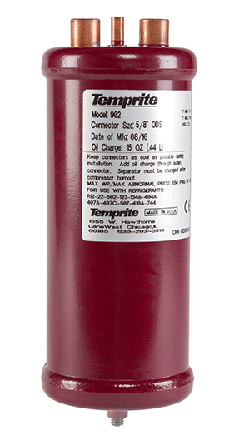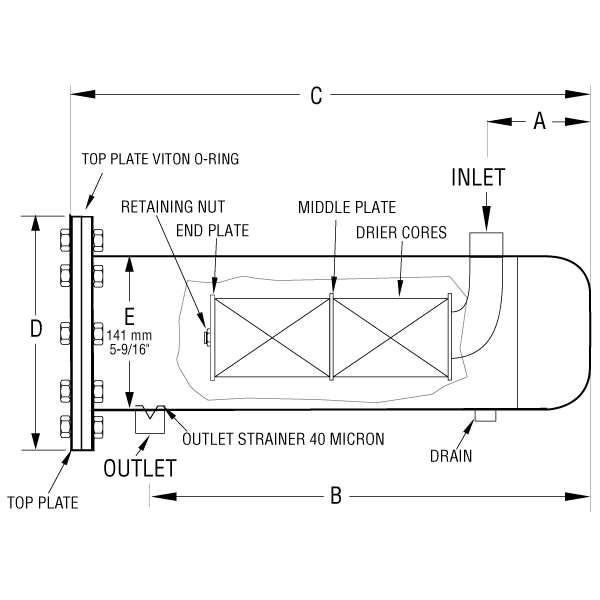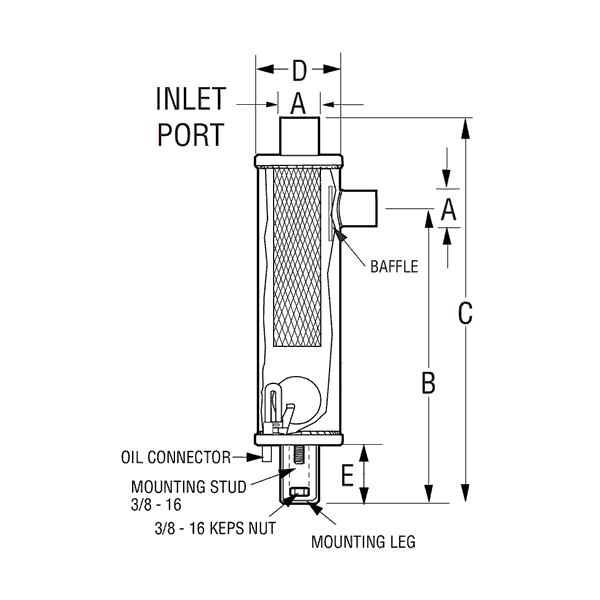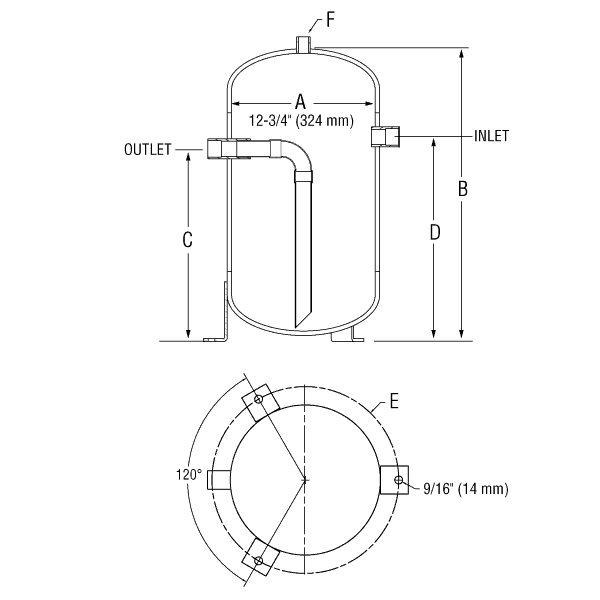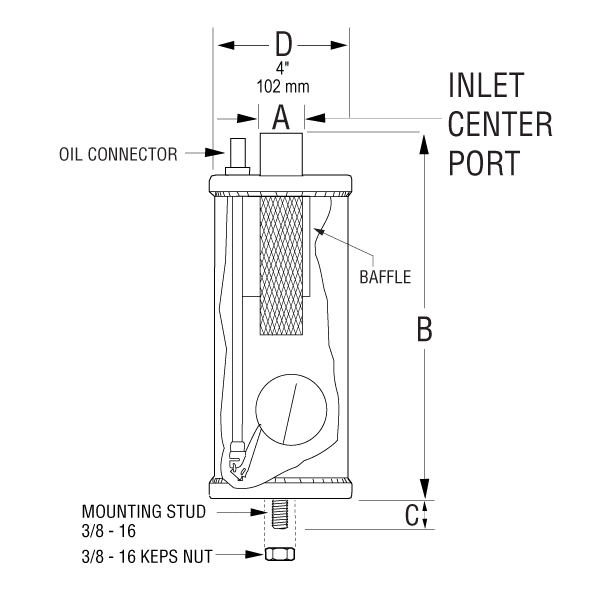Compatible with HCs and Subcritical CO2.
|
Part # |
Model # |
Max. Working Press. |
Oil Conn. |
A Dim. |
B Dim. |
C Dim. |
D Dim. |
Oil Charge |
|
090200000 |
902 |
44.8 bar |
1/4″ ODS* |
5/8″ ODS* |
10-9/16″ |
3/4″ |
4″ |
15 oz. |
*ODS = Outside Diameter Solder
THE CONNECTIONS ON THE OIL SEPARATOR MUST BE THE SAME SIZE AS (OR LARGER THAN) THE DISCHARGE LINE SIZE.
Innovative technology combined with superior design and manufacturing make Temprite coalescent oil separators the most energy-efficient separators available.
- Temprite coalescent oil separators separate and clean oil at a nominal 98.5%+ efficiency level.
- Coalescent oil separators maintain the same level of effectiveness down to 20% of maximum flow.
Temprite Technology
All Temprite coalescent oil separators are equipped with the Temprite Standard Filter. The Standard Filter uses a matrix-type borosilicate glass fiber material to do the work formerly done by impingement screens in conventional oil separators.
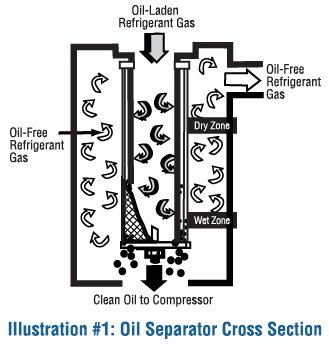 Illustration #1 shows how a coalescent oil separator moves oil-laden refrigerant gas into the filter and through the separator. Refrigerant mass flow pressure moves the aerosolized oil into the separator. Oil droplets separate from the refrigerant gas flow as they enter the filter, where the oil is stripped from the refrigerant gas. These larger, heavier droplets accumulate at the edge of the filter and then fall into the Wet Zone, collecting at the bottom of the separator where the clean oil is returned to the compressor. The clean refrigerant gas (Dry Zone) moves upward through the separator and back to the condenser.
Illustration #1 shows how a coalescent oil separator moves oil-laden refrigerant gas into the filter and through the separator. Refrigerant mass flow pressure moves the aerosolized oil into the separator. Oil droplets separate from the refrigerant gas flow as they enter the filter, where the oil is stripped from the refrigerant gas. These larger, heavier droplets accumulate at the edge of the filter and then fall into the Wet Zone, collecting at the bottom of the separator where the clean oil is returned to the compressor. The clean refrigerant gas (Dry Zone) moves upward through the separator and back to the condenser.
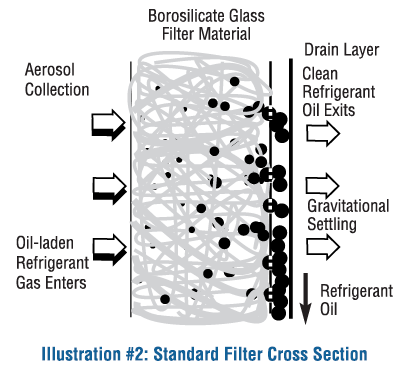 Illustration #2 shows a cross-section of a Temprite Standard Filter. System pressure moves the refrigerant oil in aerosol form outward from the center of the filter. The filter’s borosilicate fiber matrix causes the aerosolized oil to vibrate and collide with other oil molecules, creating bigger oil droplets. As the oil droplets are pushed to the outer edges of the filter by refrigerant flow, the accumulated droplets fall to the bottom of the separator through gravitational setting.
Illustration #2 shows a cross-section of a Temprite Standard Filter. System pressure moves the refrigerant oil in aerosol form outward from the center of the filter. The filter’s borosilicate fiber matrix causes the aerosolized oil to vibrate and collide with other oil molecules, creating bigger oil droplets. As the oil droplets are pushed to the outer edges of the filter by refrigerant flow, the accumulated droplets fall to the bottom of the separator through gravitational setting.
Typical Aerosol Distribution in Mass Flow
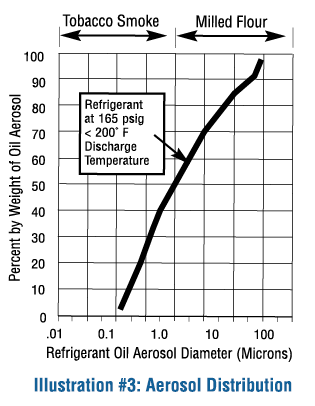 Illustration #3 shows micron particle sizes in a typical aerosol distribution ranging from .01 to 100 microns (µm) in size. Tobacco smoke and milled flour particle sizes are given as a reference point. The majority of oil particles in refrigerant discharge gas are in the 0.4 to 10 µm range, with more than 50% of the particles less than 1 µm in size. When evaluating the efficiency of your current separator, compare the micron cleaning range of your separator to Temprite coalescent oil separators.
Illustration #3 shows micron particle sizes in a typical aerosol distribution ranging from .01 to 100 microns (µm) in size. Tobacco smoke and milled flour particle sizes are given as a reference point. The majority of oil particles in refrigerant discharge gas are in the 0.4 to 10 µm range, with more than 50% of the particles less than 1 µm in size. When evaluating the efficiency of your current separator, compare the micron cleaning range of your separator to Temprite coalescent oil separators.
- Temprite Standard Filter technology cleans contaminants down to 0.3 microns in size.
Exceptional Contaminant Removal
Two of the biggest energy drains on any refrigeration system are dirt and contaminants and excess refrigerant oil. In addition, the new refrigerants coming onto the market have an enhanced solvent effect, meaning more contaminants than ever can be clogging your system.
Illustration #4 compares the filtration levels of all other types of separators to coalescent oil separators. Temprite filtration gives you the cleanest possible oil and refrigerant gas — the keys to energy efficiency, lower carbon emissions and longer compressor life. 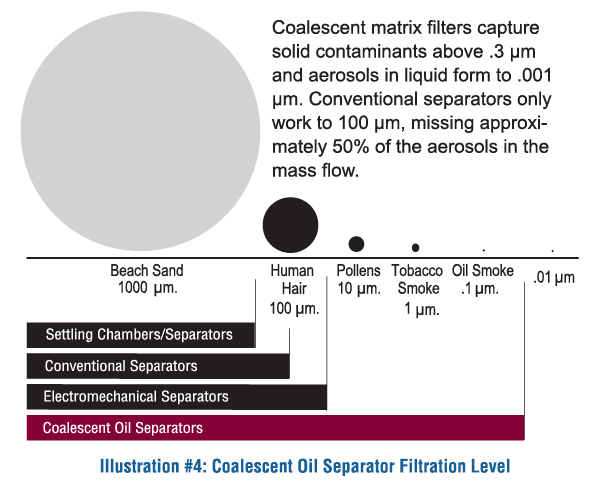
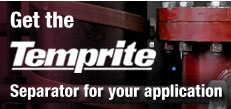 Choose the right Temprite conventional or coalescent oil separator using the Product Selector. Fill in the blanks with your system specifications and the Selector does the work. Selector results include details on the specifications input, allowing you to save and print your work. Temprite’s Quick Sizing Charts can be printed and downloaded.
Choose the right Temprite conventional or coalescent oil separator using the Product Selector. Fill in the blanks with your system specifications and the Selector does the work. Selector results include details on the specifications input, allowing you to save and print your work. Temprite’s Quick Sizing Charts can be printed and downloaded.
Resource Documents:
- Installation Instructions for all 900 Series Hermetic Coalescent Oil Separators
- Pressure Drop Vs. Particulate Loading
- Sizing Chart: 300 & 900 Series: Tons
- Sizing Chart: 300 & 900 Series: kW
- Sizing Chart: 300 & 900 Series: Natural Refrigerants, Tons & kW
- Sizing Chart: 300 & 900 Series: Ultra Low Temperatures, Tons
- Sizing Chart: 300 & 900 Series: Ultra Low Temperatures, kW
- Pre-Charge Oil Levels for All Oil Separators and Reservoirs

